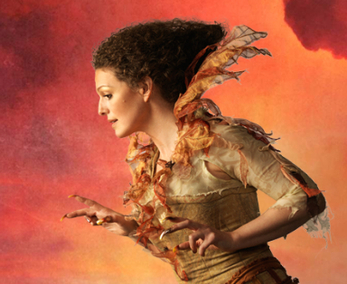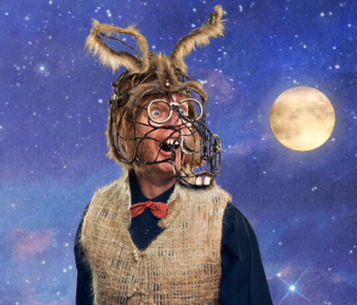The Tempest
One rope and you have a boat. Only visionary director Meg Roe could come up with a concept as original as that. Several key actors grasping onto the rope, leaning this way and that, brilliantly orchestrate the visual of a large vessel on the high seas eventually capsizing in slow motion: a stellar opening to a progressively surprising and original take on an old favourite. “This play can be stodgy but this feels new,” remarks an audience member during intermission.
The cast of surviving castaways gathers on an unusual island to face the wrath of Prospero for the kidnapping and attempted murders of he and his infant daughter, by none other than the King aboard. Mystical fairies, treachery, sleeping potions, and drunken debauchery pave the rocky road to vengeance, and maelstrom, mania, and magic spells charm us through the narrative as we make our way to the virtuous conclusion.
The timing and physicality of the actors is ethereal in its execution. A very personal blend of individual technique and talent, melded with Rob Kitsos' hilarious choreography, amuses us to distraction. The action and pacing flows without faltering and the actors appear to be living within the characters rather than performing them on stage.
Allan Morgan is captivating as Prospero, the vengeful Duke of Milan, and Jennifer Lines is mesmerizing as his magical servant, Ariel. Lines doesn't break character for one second. Even when she has nothing to do for monologues of time you can see her listening and thinking about what's taking place before her. Daniel Doheny's sense of timing is uncanny and his actions appear as natural as if he were performing them for the first time. It is by far the performances of Luisa Jojic and Naomi Wright that steal the show with their renditions of Trincula and Stephana, respectively. Their connection to the characters and the pure essence of comedy that emanates from these two is otherworldly. “Those women are too funny,” remarks a prominent theatre critic in passing.
It should be mentioned here that the actors are performing with a live orchestra, whose sense of timing and coordination is exceptional, anticipating those delicate moments when the actors move, blink, or shift their bodies.
Christine Reimer's costumes are deliciously designed but for one questionable, somewhat distracting, oversized, or perhaps strategically placed codpiece. The sound design is much cleaner and greatly improved from productions in the past, allowing for a much more intimate and audible experience.
The second half of the show is a bit bumpier than the first, but the audience has already been hooked, drawn, and landed so it's hardly noticeable. As one audience member puts it, “It is positively buoyant.”
We draw to a close with Prospero's remark, “I want art to enchant.” He indeed gets his wish with Roe's bewitching take on The Tempest.
A Midsummer Night's Dream
Get ready for a soundtrack that includes U2, the Eurythmics, Connie Frances, and Dina Washington, to name a few, in Dean Paul Gibson's rendition of A Midsummer Night's Dream.
This year Bard on the Beach has really hit its stride with the magical collaboration of Gibson, his cast, and crew. Again, this is a story that has been told a million times but in the gifted hands of Gibson, and the scene-stealing prowess of actors Scott Bellis (Bottom) and Kyle Rideout (Puck), it becomes one of the best plays Bard has showcased in years.
A shipwreck, a recovery, an elopement, a chase, a discovery, lots of fairies, a magical mistake, three enchantments, and an enigmatic thespian ass: all play their part in bringing this story to life.
AMND starts off with an entrance of umbrella-clad actors and a glimpse at Mara Gottler's amazing costumes: a spectacular blend of period and contemporary fare.
Despite the remarkable visual of monochromatic shapes and angles, what jumps out the most about the first five minutes of the play, is how articulate the actors are, how perfectly their voices are toned, and how well the sound design has been developed to showcase them properly as well as develop the overall mood: not one word of one line is lost in its delivery, which is remarkable given the unpredictable nature of the elements and the open-air environment. Nothing is yelled, though the dialogue is delivered with a strength and commitment ignorant of the obligatory ear mics. The cast is noticeably unique and well balanced in both appearance and vocal tone, which is a testament to the keen sense of the director.
Choreographer Tara Cheyenne Friedenberg gives an intro to the fairies that is both entertaining and comedically clever in its masking of its level of difficulty.
Enter Puck, the mischievous fairy and servant to Oberon (Ian Butcher), who Gottler outfits with an enormous, bouncy tutu. Puck is no ordinary fairy. Gibson gives him full reign to push the boundaries as far as possible. He is adorable and brazen, and delectably risqué: yes, that Puck in tutu works.
Sereana Malani (Helena) does a wonderful job of blending a contemporary thread of physicality to balance her Shakespearean dialogue.
The fairy song, the dances, the one-liners from classic songs, it all works magic without breaking pace, but the scene to steal all scenes is Scott Bellis's and Haig Sutherland's (Flute) culmination of their play-within-a-play, which owes great kudos to the props department for their ingenuity in putting those finishing touches in place.
Two for two, Bard has knocked it out of Vanier Park.
Click HERE for tickets, times, and info.




 RSS Feed
RSS Feed
